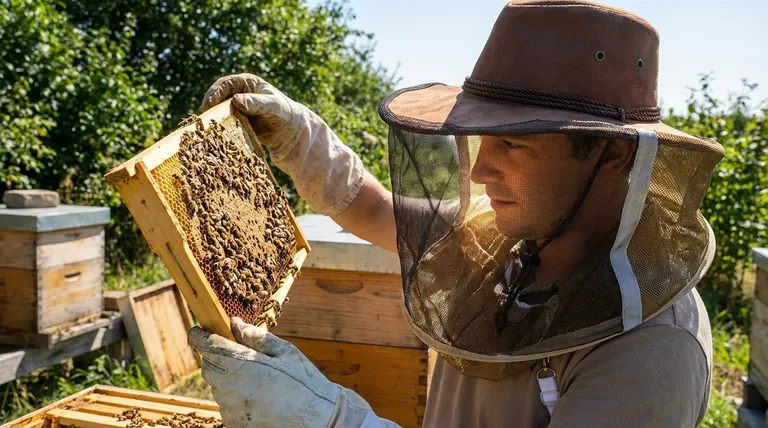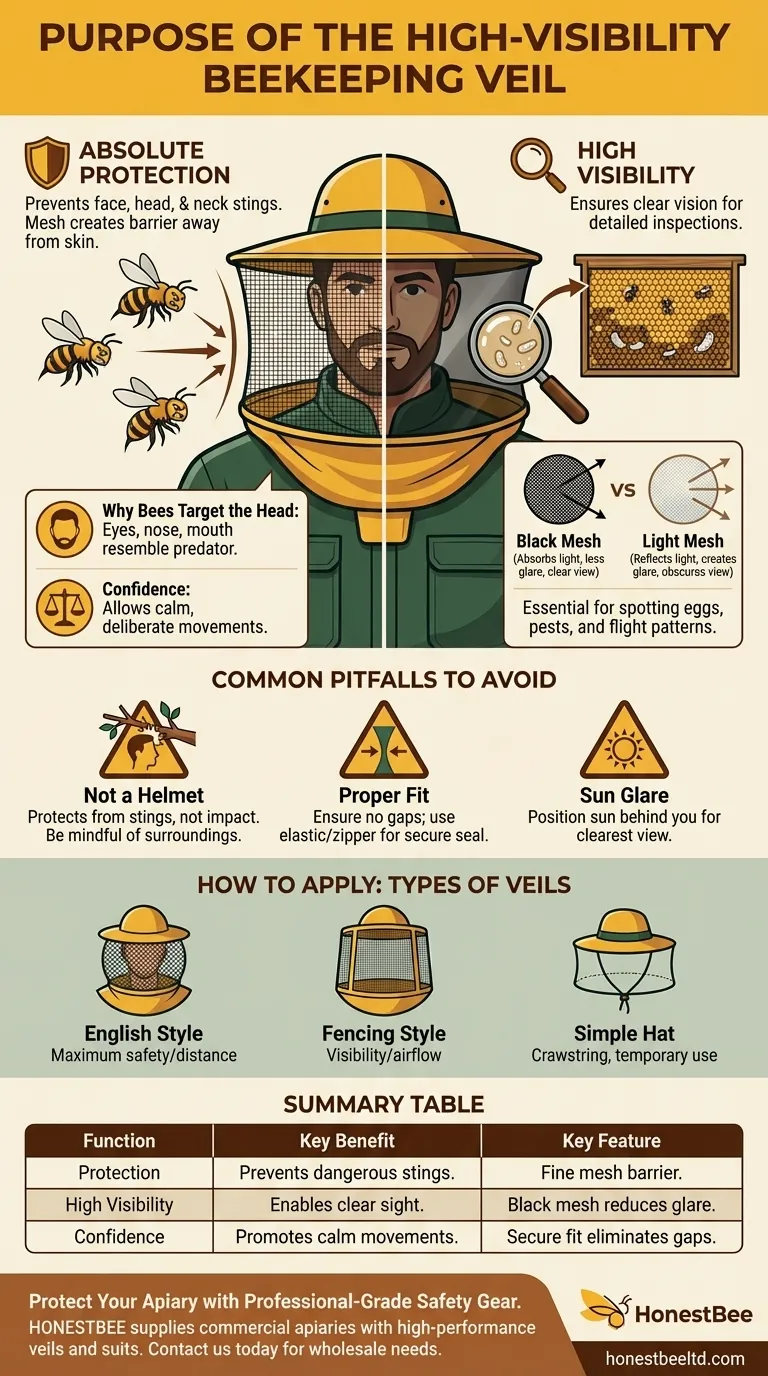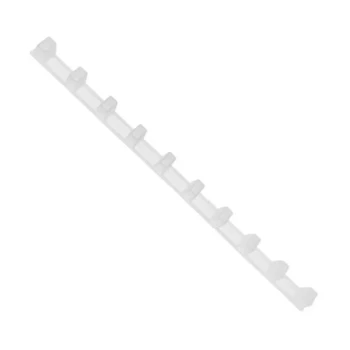The primary purpose of a high-visibility beekeeping veil is twofold: to provide absolute protection for your face, head, and neck from bee stings, while simultaneously ensuring your vision remains as clear and unobstructed as possible. The "high-visibility" aspect is a specific design feature that allows you to perform detailed hive inspections without the mesh creating a significant visual barrier or causing eye strain.
A beekeeping veil is not merely a screen; it's a critical piece of safety equipment engineered to solve the dual problem of preventing stings to your most vulnerable area while preserving the clarity of vision required for effective beekeeping.

The Primary Function: Absolute Protection
A bee sting on the hand is painful; a sting on the face can be dangerous, especially near the eyes or for individuals with allergies. The veil is your first and most important line of defense.
Why Bees Target the Head
Defensive bees are instinctually programmed to target the most vulnerable areas of a potential predator. Your head and face—particularly the dark areas of your eyes, nose, and mouth—can resemble the face of a natural predator like a bear, making it a primary target.
Creating a Physical Barrier
The veil consists of a fine mesh that hangs from a wide-brimmed hat. This design ensures the mesh remains taut and away from your skin, creating a space that a bee's stinger cannot cross, even if the bee is crawling on the surface of the veil.
A Matter of Calm and Confidence
Knowing you are protected allows you to remain calm and deliberate in your movements. Panic or sudden actions can agitate a colony, so the confidence a good veil provides is a safety tool in itself for both you and your bees.
The Critical Importance of High Visibility
Protection is useless if you cannot see what you are doing. Effective beekeeping requires careful observation of very small details within the hive.
The Need for Detailed Inspection
A beekeeper must be able to spot minuscule bee eggs (which are the size of a grain of salt), identify larvae, and check for signs of pests or disease. A standard screen or light-colored mesh would make this intricate work nearly impossible.
How "High-Visibility" is Achieved
High-visibility veils are almost always made of black mesh. This is intentional. Black material absorbs more light and creates less glare than white or light-colored mesh, making it far easier for the human eye to see through it, much like looking through a clean screen door.
Maintaining Situational Awareness
Clear vision isn't just for looking at frames. It is essential for observing the flight patterns of your bees, navigating your apiary safely, and being aware of your general surroundings.
Common Pitfalls to Avoid
While essential, not all veils are created equal, and improper use can negate their benefits. Understanding the limitations is key to staying safe.
A Veil is Not a Helmet
The veil protects from stings, not physical impact. Be mindful of your surroundings, especially low-hanging branches when working in your apiary.
Proper Fit is Non-Negotiable
Ensure there are no gaps between your veil and your suit or shirt. Bees are experts at finding small openings. A well-designed veil will have elastic or a zipper to create a secure seal.
Sun Glare Can Still Be an Issue
Even with black mesh, working with the sun directly in front of you can create glare. Position yourself so the sun is behind you or to the side for the clearest possible view into the hive.
How to Apply This to Your Equipment
Choosing a veil depends on your beekeeping style and comfort level. Your decision should always prioritize the balance of safety and visibility.
- If your primary focus is maximum safety and distance: A round "English" style veil, often integrated into a full suit, keeps the mesh rigid and far from your face on all sides.
- If your primary focus is the best possible visibility and airflow: A "fencing" or "square" style veil often provides a wider field of view and can feel less constricting, but you must ensure it doesn't rest against your chin or nose.
- If you are a casual observer or need temporary protection: A simple hat and drawstring veil can suffice, but meticulously check for gaps around your neck before approaching a hive.
Ultimately, the right veil is the one that lets you work confidently, allowing you to focus on the health of your bees rather than the threat of a sting.
Summary Table:
| Function | Key Benefit | Key Feature |
|---|---|---|
| Protection | Prevents dangerous stings to the face, head, and neck. | Fine mesh creates a physical barrier away from the skin. |
| High Visibility | Enables clear sight for spotting eggs, larvae, and pests. | Black mesh design reduces glare and eye strain. |
| Confidence | Promotes calm, deliberate movements that keep bees calm. | Secure fit (elastic/zipper) eliminates gaps for total safety. |
Protect Your Apiary with Professional-Grade Safety Gear
Your safety and the clarity of your inspections are paramount. HONESTBEE supplies commercial apiaries and beekeeping equipment distributors with high-performance, durable beekeeping veils and suits designed for the demands of professional beekeeping.
We understand that your productivity depends on reliable equipment you can trust. Let us equip you with gear that provides absolute protection and superior visibility, so you can focus on what matters most—the health of your hive.
Contact HONESTBEE today to discuss your wholesale needs and discover our full range of commercial beekeeping supplies.
Visual Guide

Related Products
- Heavy Duty Cowboy Beekeeper Hat with Visibility Veil Outdoor Professional Beekeeping Protective Gear
- Beekeeper Cowboy Hat and Veil for Beekeeping
- Square Folding Bee Hat Veil with String for Beekeeping
- Professional Beekeeping Suit for Kids and Girls Childrens Bee Keeper Suit
- Durable Galvanized Steel Frame Grip
People Also Ask
- What are the benefits of the lightweight fabric used in the beekeeping hat veil? Enhanced Visibility & Comfort for Hive Work
- What features enhance the quality of the beekeeping veil? Choose the Right Protection for Your Apiary
- Why are a hat and veil considered the most important parts of beekeeping protective gear? Essential Protection for Your Face and Confidence
- Why is head protection important for beekeepers? Essential Safety for Confident Hive Management
- How does the design of the beekeeping hat ensure comfort during extended use? Maximize Comfort for Long Apiary Hours



















